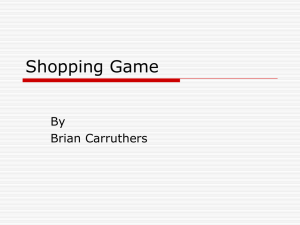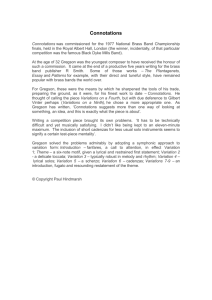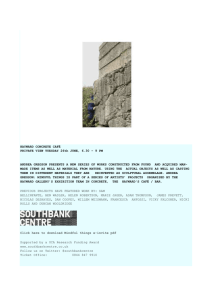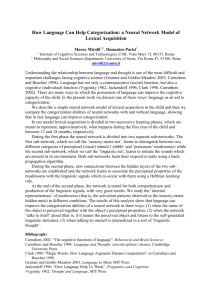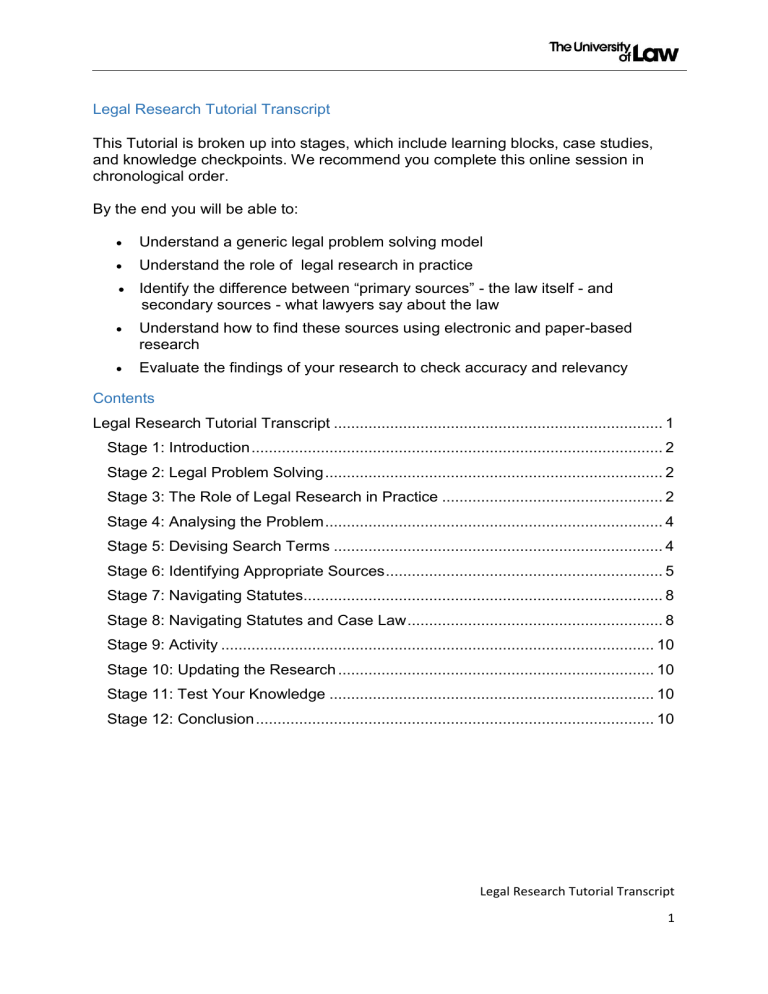
Legal Research Tutorial Transcript This Tutorial is broken up into stages, which include learning blocks, case studies, and knowledge checkpoints. We recommend you complete this online session in chronological order. By the end you will be able to: Understand a generic legal problem solving model Understand the role of legal research in practice Identify the difference between “primary sources” - the law itself - and secondary sources - what lawyers say about the law Understand how to find these sources using electronic and paper-based research Evaluate the findings of your research to check accuracy and relevancy Contents Legal Research Tutorial Transcript ............................................................................ 1 Stage 1: Introduction ............................................................................................... 2 Stage 2: Legal Problem Solving .............................................................................. 2 Stage 3: The Role of Legal Research in Practice ................................................... 2 Stage 4: Analysing the Problem .............................................................................. 4 Stage 5: Devising Search Terms ............................................................................ 4 Stage 6: Identifying Appropriate Sources ................................................................ 5 Stage 7: Navigating Statutes................................................................................... 8 Stage 8: Navigating Statutes and Case Law ........................................................... 8 Stage 9: Activity .................................................................................................... 10 Stage 10: Updating the Research ......................................................................... 10 Stage 11: Test Your Knowledge ........................................................................... 10 Stage 12: Conclusion ............................................................................................ 10 Legal Research Tutorial Transcript 1 Stage 1: Introduction The primary function of a lawyer is to solve problems for their client, and legal research skills play an essential part in being able to successfully discharge their role. Stage 2: Legal Problem Solving Let’s examine the following scenario... Imagine you’re a solicitor and a client, Mr. Carruthers, has a problem. He’s bought a dodgy car from Gregson’s Autos, a second-hand car dealership and now he wants to know what he can do. You have no knowledge of this area of law. So how do you most effectively solve Mr. Carruthers’ problem? There are six steps which you’ll need to take to solve Mr. Carruthers’ problem. First: identifying the client’s objective. Once a client has told you their story, you must distil it all into an objective that’s easier to focus on. In the case of Mr. Carruthers’, his objective is to seek some sort of remedy from Mr. Gregson. Now you must identify any potentially relevant law. This is where legal research comes in. Researching the law may cause you to raise questions of fact... ...which you will need to answer before you can deal with certain legal issues. This law/fact process may continue back and forth for some time. At this point, you might need to ask Mr.Carruthers for more detailed information about the car, or Mr. Gregson’s misleading sales pitch. Once you’re happy you have all of the facts straight, and you have found the relevant law, it’s time to apply the law to the facts. This is a key skill – you need to be able to show how the law you are putting forward applies to your case. Your client wants answers! So the next step is to identify the possible solutions to your client’s problem. In Mr. Carruthers’ case, the options will probably be whether to go to court or to send a solicitor’s letter to Mr. Gregson. Remember, the aim is to get Mr. Gregson to give some sort of recompense to Mr. Carruthers. And, finally, you select the most appropriate solution for your client. Hopefully Mr. Gregson will at least give Mr.Carruthers a refund. Stage 3: The Role of Legal Research in Practice Let's now take a look at how legal research works in practice. Let’s say you’ve identified Mr. Carruthers’ objective- to get some sort of recovery from Mr. Gregson. Mr. Carruthers has told you his story but you don’t know this area of law. Which of the responses below would best serve Mr. Carruthers? Let’s begin by looking at the facts of the case. The paragraph below is taken from the first page of Legal Research Tutorial Transcript 2 the report. Take a few moments to read this and identify, first, the charge against Mr.Goodwin, and second, the grounds upon which he appealed. 1. Well the answer is this… [gives off-the cuff advice on the basis of instinct alone] 2. I’m afraid I can’t advise you as my area’s probate 3. You’ve clearly got a contractual dispute here. Although I have a little knowledge in this area, I think I’d better remind myself of a few things. How about I give you a ring tomorrow with some advice? 4. You’ve clearly got a contractual dispute here. Although I have a little knowledge in this area, I think I’d better remind myself of a few things. How about I give you a ring tomorrow with some questions? It's important to ensure you are providing your client with the right responses, even at this early stage. The best answer is response 4, which is very similar to response 3, but this time we intend to ring back with more questions before giving advice at a later date. The research will throw up some answers, but some new questions too, leading to further research. You can work with your client to find an answer. We’ll return to this scenario, as it raises a lot of useful legal research issues. But whether it’s a second-hand car, or a question on takeovers and mergers, you must get the law right and the only way to do this is through good legal research. Each legal research question may be different, but the same strategy works for all of them. Let’s look at each individual stage of this method for conducting your research. Analyse the problem: make sure you understand it and clarify any relevant facts. Then identify the legal issues that arise. Sometimes it will be a single issue; sometimes there may be a number of related issues. Devise search terms that distil these legal issues into specific “keywords”. These will become the search terms you either look up in a printed index, or type into a database. Once we know what we’re looking for, the next step is to identify the appropriate legal resource: there are hundreds of them. Select with care. If you choose wrongly, your research will take longer, and your results may be inaccurate. Think about updates: the law changes constantly, so you must make sure that the law you find is as up-to-date as possible. For example, printed “looseleafs” allow pages to be replaced on a regular basis. Also, do not assume that an electronic source is wholly up to date - check by cross referencing with other sources. Legal Research Tutorial Transcript 3 Finally, you must present your findings in an appropriate format. For example, if the problem is complex, involving several linked issues, list the issues and report on each one separately. Stage 4: Analysing the Problem Let’s review our example scenario before we apply this research method. Your client has bought a second-hand car from Gregson’s Autos. Before purchase, he asked the proprietor, Greg Gregson, whether the car had had any crashes. He was wrongly told that it had not and then the car broke down because it was defective. So, applying our strategy, our first step is to analyse the problem. Mr. Carruthers feels cheated because he hasn’t got the car he thought he’d paid for. What sort of issues does this raise? Below are some potential areas of law which you might consider. Fraud seems appropriate given the facts of the case, and will need to be researched further to see if this can provide a solution for the client. Negligence can be discounted as Gregson made no mistakes. His actions were deliberate. Theft is conceivably relevant, but is inappropriate in this case as Carruthers wants a remedy like money; he doesn’t want Gregson punished. Sale of Goods seems appropriate given the facts of the case, and will need to be researched further to see if this can provide a solution for the client. Contract seems appropriate given the facts of the case, and will need to be researched further to see if this can provide a solution for the client. Inheritance can be dismissed out of hand, as it has no relevance to the case. Stage 5: Devising Search Terms This next stage will save you lots of time if you get it right. Whether you’re using a book or a database, you need to use either an index or search engine to find the relevant law. It’s clearly important to look for the right terms and to illustrate this, we’re going to focus on the fraud aspect of the problem. Your client has bought a second-hand car from Gregson’s Autos. Before purchase, he asked the proprietor, Greg Gregson, whether the car had had any crashes. He was wrongly told that it had not and then the car broke down because it was defective. Let’s assume you have a basic understanding of the area and have thought of several search terms. Which do you think will yield the most useful results? Often it’s just a question of making an educated guess. Legal Research Tutorial Transcript 4 The trick is to use words which are wide enough to cover the potential subject matter, but not so wide as to give you too many options. Grammar is another factor. A trap to avoid is using less common alternatives of words. If you do, you’re restricting your potential field of research. Equally, try to avoid narrowing your search by using full prose, as not all search engines and legal databases support natural language searches. You may have to combine search terms using connectors such as AND, OR or NOT. We can say goodbye to Fraud, as the concept is far wider than merely cheating someone into buying goods. Fraudulent Statement would be an appropriate search term in this case. Also try to avoid using terms which might have limited meanings in law. For instance, Carruthers may feel seriously defrauded by Gregson but to use “serious fraud” as a search term would be a mistake as it is a distinct area of law. We can discount Fraud in the Sale of a Car, as it’s too narrow. Any search using these terms would exclude fraud in analogous situations. Try to avoid narrowing your search by using full prose, like “fraud in the sale of goods” as not all search engines and legal databases support natural language searches. Fraud Sale of Goods would be an appropriate search term in this case. We can discount Fraudulent Selling of a Car, as it’s too narrow. Any search using these terms would exclude fraud in analogous situations. A trap to avoid is using less common alternatives of words, such as “fraudulent selling of a car”, If you do, you’re restricting your potential field of research. Obviously framing your search terms is an acquired skill which develops with practice. If you know little about the subject matter, a good place to identify possible search terms is a book index or legal dictionary. Stage 6: Identifying Appropriate Sources The third stage of our research strategy is to identify appropriate sources. These are the main issues concerning the source of information: 1. Primary v Secondary Sources 2. Paper v Electronic Sources 3. Electronic Sources: Free v Subscription Legal Research Tutorial Transcript 5 Primary v Secondary Sources Sometimes you need to look at the law itself, and sometimes you may want to read about the law. Let’s start by clarifying the distinction. Primary - Halsbury's Statutes, Official text of an Act, Law Report, Casebook. Secondary - Halsbury's Laws, Textbooks, Practitioners' Works, Journal Articles (paper and electronic), Websites These are examples of the two types of source. Put simply, primary sources are the law itself, and secondary sources summarise and comment upon that law. Commonly, you’ll start your research looking at a secondary source and then, for detail and clarification, you’ll look at the law itself. The main sources of law in England and Wales are cases and statutes. We’ll focus on finding these in this Tutorial. Activity – Available online. Here is an example of a possible reading strategy. Early basic research: Examples include Halsbury’s Laws (commentary on the law of England and Wales), and Contract Law Manual (The University of Law) Focused research: Once you’re familiar with the basics of an area, it’s a good idea to look at a detailed textbook, such as a practitioner text, and maybe refer to some other basic commentary such as a legal journal article. Detailed points of law: It’s at this stage that you might wish to start looking at primary sources, for example a case report, as the secondary sources require you to consider in more detail original “black letter” law. Examples include The Sale of Goods Act 1979 – online database – and The Misrepresentation Act 1967 – online database. Further interpretation: Occasionally you may need to look at an academic discussion - for example in legal journals. Examples include “Damages and the Misrepresentation Act 1967”, Law Quarterly Review Oct 1991. Further detailed points of law: Examples include Long v Lloyd [1958] 2 All ER 402 (law report), and MacGregor on Damages: advanced practitioners guide. Avoid: Finally, as with all sources, some internet sites are better than others. Choose carefully – otherwise, you could be relying on false or questionable material. Paper v Electronic Sources Legal Research Tutorial Transcript 6 When it comes to legal research is it better to use paper sources or electronic ones? There is no simple answer to this question. It will always depend on a number of different factors. Here, we’ll look at the advantages and disadvantages of both. In favour of paper: 1) It’s often easier to have books open for reference, than to be constantly moving from one electronic source to another. Many books tend to have a clearer layout than their electronic equivalents, especially statutes. 2) Sometimes, especially with unfamiliar areas of law, it’s easier to find the information you want by using a printed index than by using a search engine. 3) Cost is another issue: for firms it’s often cheaper to have common works of reference on a bookshelf; than to bear the cost of frequent electronic searches. 4) One major problem with electronic resources is quality control-particularly information on free websites. Sometimes it’s easy to evaluate the authority of a website, such as a government site, but if it isn’t clear consider things such as who is the author of the source, who is the intended audience, and when it was last updated. 5) Finally, as we all know, computers can crash. Books can’t. In favour of electronic: 1) Computers are superb at sifting through vast quantities of information. If you use the right search term, a computer will find exactly what you want in seconds, and will not accidentally miss something out. The trouble is that the computer is only as good as the instructions you give it. 2) And, whilst it’s impossible to carry dozens of legal books around, it’s easy to go on line almost anywhere, at any time. 3) Books are difficult to keep up to date, although some volumes use loose-leaf formats to allow ongoing updates. Some online resources are kept up to date automatically. 4) And one less obvious, but important, advantage, if you use some subscription databases, is hyperlinking - the ability to cross-refer, at the click of a mouse, between related cases and statutes etc. Clearly, then, there’s a place in our research for both types of source. The answer is to use both, as and when appropriate. Electronic Sources: Free v Subscription Legal Research Tutorial Transcript 7 The Web is a wonderful source, but be aware of indiscriminate use of search engines such as Google. A search engine can yield many useful legal and non-legal sources, but you must consider the reliability of the source, and check that it’s not out of date. Hence our discounting of Jim Dandy’s Student Law Web Blog! Here are some examples of good, useful, free internet sites. Government / official websites Legal Gateways e.g. infolaw.co.uk Also, don’t forget Twitter and legal blogs, as many legal specialists use these to raise issues and discuss changes in the law. Legal Gateways are particularly handy, as an expert has selected reliable internet sources for you to access. Examples of such sites are the Delia Venables site, and infolaw.co.uk, a gateway for the UK legal web. There are also specialist legal databases with sophisticated internal search engines such as Westlaw and LexisLibrary. Finding Statutes Statutes are the primary source of law in the UK, so it’s important to use them correctly. Often it’s easier to use a paper version, such as Halsbury’s Statutes, but an online source such as LexisLibrary or Westlaw, can be especially useful if you need to hyperlink to related material. Furthermore, online versions from subscription databases will regularly be updated. If you want to use a paper version of a statute or statutory instrument such as Halsbury’s Statutes, just be aware that the updating process may involve several stages. You must follow carefully any updating instructions. Before we continue with our scenario, let’s take a look at two key areas of identifying appropriate sources – navigating and interpreting statutes, and identifying relevant case law. Stage 7: Navigating Statutes Available online. Stage 8: Navigating Statutes and Case Law Now you can navigate your way round a statute, we’re going to look at an extract from the Sale of Goods Act, before moving on to look at case law. Let’s say that we’ve decided that section fourteen is relevant to Mr. Carruthers’ case. We think that Gregson may have breached the contractual promise, implied by the Sale of Goods Act to all relevant contracts, that goods will be of satisfactory quality. Legal Research Tutorial Transcript 8 Section 14 sub-section 2 of the Sale of Goods Act is directly relevant to Mr. Carruthers’ case. Put simply, if a business sells a defective product, it will usually be in breach of contract, so Gregson may be in breach of contract as a result of this. Look at section 14(2). Take a moment to think about which sub-sections relate to whether Gregson is in breach of contract. OK, let’s see if you’re right. Sub-section 2 contains the section’s central provision, stating that there’s an implied term that the goods are of satisfactory quality. The other two sub-sections give guidance on how to determine whether the goods supplied are of satisfactory quality. So for example, we’d need to ask Carruthers precisely what was wrong with the car and whether he examined it before he bought it. Remember that fact-gathering and legal research inter-relate, and that we may need to gather more information before giving advice. Note the capital letters in the sub-section numbers. This means that they have been inserted by later legislation, so we know that the original Sale of Goods Act from 1979 has been amended. This is common. If you look at sub-section 2B you’ll see that because the car broke down, at least four of the five example factors listed are satisfied. Note, however, that these are not the only factors (the section says “among others) and that the list presents alternatives. With lists, it’s vital to note whether they require all elements to be satisfied, or merely one, or, as here, none. Case Law As we’ve already seen, England and Wales is a common law jurisdiction. Case law is a vital part of our legal system, and being able to find cases on a particular issue is a key skill. In Carruthers’ case, let’s say a textbook has indicated that we need to look at the case of Long and Lloyd. We can do this either online or via paper-based sources. The main problem is that few sources contain all the cases you might need. However, most cases you’ll come across will be contained in one of the main law reports. Although only the most important cases are formally reported, it is sometimes possible to get hold of reports of “unreported” cases, principally online. The multiplicity of cases is one reason for the variety of law reports. Another is that they’re published by different publishers at different times. Now let’s find Long and Lloyd for Mr. Carruthers. The case relates to the availability of remedies resulting from a lie such as Gregson’s. Legal Research Tutorial Transcript 9 The first and most important step is to find its citation - the set of numbers and letters which appear after the year. As this identifies where the case is reported, there may be several citations for a single case but, where a case has been reported in the Official Law Reports (such as Appeal Cases), you should always select that citation, as it will be the most authoritative report. It’s easy to find the citation of a case using a case citator or textbook. Here the citation has directed us towards the All England Law Reports. 1958, 2, All ER, 402 is referring us to page four hundred and two of the second volume of the All England Law Reports for 1958. There are also casebooks which are collections of case extracts, often with helpful commentary. This is useful as a lot of the preliminary work has been done for you they contain only what the editor thinks is the useful part of the case. Stage 9: Activity Available online. Stage 10: Updating the Research Law is not a dead subject. Case law develops by virtue of precedents being refined or overruled and statutes are sometimes repealed or amended. So you can’t afford to assume the law’s the same as it was last year. Neither can you presume that your sources tell the whole story. A key part of legal research is ensuring that your research is brought up to date. Let’s say we advised Mr. Carruthers on the basis of a textbook from 1990. The Sale of Goods Act has been amended greatly since then. With subscription-based online sources, and some free ones such as Europa, the information is regularly updated by the editors - although not necessarily every day. With books, even loose-leaf publications, you often need to go through a two or three-stage updating process. Again, this will vary with each source. Stage 11: Test Your Knowledge Available Online. Stage 12: Conclusion We’re now near to solving Mr. Carruthers’ problem. But writing the research report is not the end of the matter. So what’s going to happen to Mr. Gregson? Well, he may be in breach of contractual terms created by the Sale of Goods Act, and he may have made a misrepresentation. He’ll probably have to take the car back and pay damages. If you look at our problem solving model, we have reached step four. You’ve still got to identify the possible solutions for Mr. Carruthers and select the most appropriate, on his instructions - he can either negotiate with Gregson or sue him. Legal Research Tutorial Transcript 10 Image- Available Online Having worked through this Tutorial, you should now be able to: Understand a generic legal problem solving model Understand the role of legal research in practice Identify the difference between “primary sources” - the law itself - and secondary sources - what lawyers say about the law Understand how to find these sources using electronic and paper-based research Evaluate the findings of your research to check accuracy and relevancy End of Document Legal Research Tutorial Transcript 11
